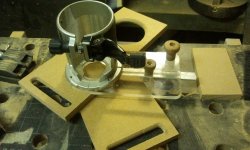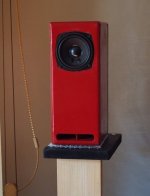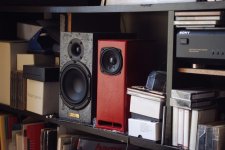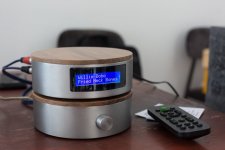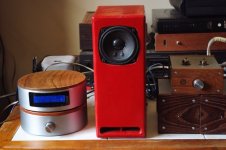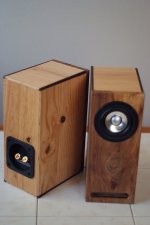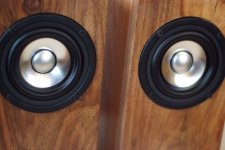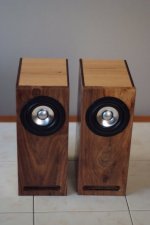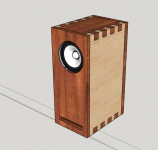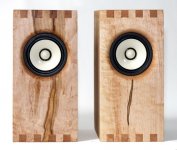Member
Joined 2009
Paid Member
Hi Mike - welcome on board !
I would still recommend the FR88EX as a proven design, it's still fairly popular and performs very well. However, you should look around at other DIY projects for an idea of alternatives. Member 'xrk971' and others have been very active with some interesting projects made from foam-board that would make for a relatively lightweight speaker although it may not hold-up to constant travel.
I would still recommend the FR88EX as a proven design, it's still fairly popular and performs very well. However, you should look around at other DIY projects for an idea of alternatives. Member 'xrk971' and others have been very active with some interesting projects made from foam-board that would make for a relatively lightweight speaker although it may not hold-up to constant travel.
My version 
My first DIY speakers: thanks a lot Bigun, for the nice plans and very good instructions.
I've been re-reading this thread for quite a while, and finally decided to bite the bullet.
However, I do not have the Fountek FR88EX drivers (and they're not cheap here in EU), but I do have a pair of Visaton FRS8 drivers - and, thanks to Bknabe who confirmed that they can be used in this project, I finally went ahead a few days ago and decided to use the Visaton FRS8 drivers for my "Martello" build.
I used MDF (not *exactly* 12mm, more like 11.5mm...), and following the excellent instructions in this thread, managed to make a half-decent looking pair of speakers.
Lo and behold, they play quite nicely!!! Not much real bass, as can be expected, but what bass is there is quite OK.
In short, the final project (and sound) are better than I expected.
Bigun, I quite liked how your first pair turned out, so my pair is obviously inspired by your build - I like how these look in red
I might add the speaker grille later, but they are OK already.
Thanks again for the inspiration and the plans!
(PS: the last photo shows my "Red Devils" next to Audio EPilog "Ice" speakers, which are in a league of their own - Audio Epilog is a well-known Croatian speaker manufacturer, and these "Ice" models are really wonderful...)
My first DIY speakers: thanks a lot Bigun, for the nice plans and very good instructions.
I've been re-reading this thread for quite a while, and finally decided to bite the bullet.
However, I do not have the Fountek FR88EX drivers (and they're not cheap here in EU), but I do have a pair of Visaton FRS8 drivers - and, thanks to Bknabe who confirmed that they can be used in this project, I finally went ahead a few days ago and decided to use the Visaton FRS8 drivers for my "Martello" build.
I used MDF (not *exactly* 12mm, more like 11.5mm...), and following the excellent instructions in this thread, managed to make a half-decent looking pair of speakers.
Lo and behold, they play quite nicely!!! Not much real bass, as can be expected, but what bass is there is quite OK.
In short, the final project (and sound) are better than I expected.
Bigun, I quite liked how your first pair turned out, so my pair is obviously inspired by your build - I like how these look in red
I might add the speaker grille later, but they are OK already.
Thanks again for the inspiration and the plans!
(PS: the last photo shows my "Red Devils" next to Audio EPilog "Ice" speakers, which are in a league of their own - Audio Epilog is a well-known Croatian speaker manufacturer, and these "Ice" models are really wonderful...)
Attachments
Member
Joined 2009
Paid Member
Nice work Denis !
Great to see that the enclosure can be used with other drivers and produce pleasing results. I'm not surprised the bass is a little less because your driver has some different T/S parameters, including a higher resonant frequency. There may be other drivers worth trying out in this box too.
Great to see that the enclosure can be used with other drivers and produce pleasing results. I'm not surprised the bass is a little less because your driver has some different T/S parameters, including a higher resonant frequency. There may be other drivers worth trying out in this box too.
Last edited:
I'm not surprised the bass is a little less because your driver has some different T/S parameters, including a higher resonant frequency. There may be other drivers worth trying out in this box too.
Actually, there is more bass than I expected: I never actually thought I'd get so much bass from such a small speaker. After the initial listening, I tried listening some more demanding material (bass-wise): some Marcus Miller ("Free"), and was pleasantly surprised
My other speakers ("Audio Epilog" - shown in the last photo) have a lot more bass, but that was to be expected.
Still, I really can't complain about the finished Martellos - I've been listening to them for a few days, and the drivers have probably not been "broken in" properly yet
Anyway, I'm more than happy with the results: these can easily be used as standard speakers (not only for desktop duty).
I really wanted to see what can be achieved with a cheap driver in a 2liter enclosure, and I'm more than happy.
Next step: design and make a par of speakers which would fit the design of the rest of the stuff I make - in round aluminium enclosures
The attached photo of my kit will give you the idea of the design... The round enclosures have a diameter of 15cm, and height of about 4.5cm each.
The photo shows my "pimped up" TPA3116D2 Class D amp on the bottom, and the music source is my variant of Raspberry Pi audio server with 24/192 DAC (top enclosure with the LCD display)...
The sound is excellent
Once again, big thanks for a very nice design and plans!
Attachments
Last edited:
Member
Joined 2009
Paid Member
That's good to know, the Fountek driver isn't so easy to get for some folk and the special magnets make them more expensive so with other driver choices maybe more people would like to build them !
By the way, I love that server design - do you have details on a thread on this forum somewhere - please post a link if you do ?
By the way, I love that server design - do you have details on a thread on this forum somewhere - please post a link if you do ?
By the way, I love that server design - do you have details on a thread on this forum somewhere - please post a link if you do ?
Unfortunately, no build photos anywhere, I don't know in which section of the forum these would go
But, the enclosures are made from CNC machined aluminium (150mm diameter - 15cm). The server contains Raspberry Pi plus appropriate DAC - usually Hifiberry 24/192 DAC, and is powered by a solid external good quality power supply (5V/3A). The top is made of solid wood (the one in the photos uses walnut) - handmade using router to get the rebate that goes into the enclosure, with the final shape cut on a bandsaw. The display is a usual 2x16 character LCD, driven by my custom Python script. The OS on the Raspberry is RuneAudio: RuneAudio - Embedded Hi-Fi music player
It also has a remote control, so it's quite versatile: you can control it using a smartphone/tablet/laptop/whatever, or just grab the remote and use it to control volume start/stop, etc...
Relatively simple to set up, and once the networking is set up, using it is quite easy: I've given a lot of thought to the ease of use and ergonomics. The design is my own, and it took almost two years to perfect: the LCD "cover" in the front, for example, was very difficult to solve, and I'm still not 100% happy with it.
In short, it was a compromise, because I wanted to keep the manufacturing cost reasonable, so that the final price is still "palatable". It could have been better, but at disproportionally higher cost... The most expensive part, as you can imagine, is the enclosure
The only machined part of the enclosure is the initial CNC (making of precisely dimensioned openings in the back for the Raspberry Pi connectors and the front opening for tight-fitting LCD).
Except for the initial CNC dimensioning and machining, I make everything else myself, by hand
I also have a version without the LCD and remote, which is perhaps more "elegant" or simplistic - but it works the same, just without the LCD and IR remote.
Sorry for hijacking the thread - now let's get back to Martellos
Rgds,
Denis
Attachments
Another set!
I just wanted to show another pair I built, this time using somewhat diferent materials - and different drivers.
The front baffle is walnut, sides, top, bottom and back are oak, and the drivers are Fountek FE85 - much cheaper than FR88EX - and they still sound quite nice....
- and they still sound quite nice....
I just wanted to show another pair I built, this time using somewhat diferent materials - and different drivers.
The front baffle is walnut, sides, top, bottom and back are oak, and the drivers are Fountek FE85 - much cheaper than FR88EX
Attachments
Member
Joined 2009
Paid Member
Wow, that walnut front baffle is gorgeous !
The knotty side panel looks a little scruffy in comparison, have you considered painting the side and back panel in a flat black, with the front baffle in dark walnut it could look super posh.
Thanks
I've done this pair as a prototype, since it's a different material than what I used previously - I also changed the joints somewhat, and I have the back panel "seated" in the grooves cut in the sides and back and top...
The sides, top and bottom are actually not "real" wood - it's actually oak floor panelling, with just a thin layer of oak on top
- cheaper than the "real thing", and also easy to work with. I've used the knotty sections intentionally, since I wanted a somewhat "rustic" appearance.
The front baffle *is* real knotty walnut with some interesting grain pattern.
I'm attaching a Sketchup drawing for these, which may perhaps be of help to future builders
The next pair will again be different, it is planned as a step forward - real wood on all sides, using finger joints (box joints) - see attached image.
Attachments
Member
Joined 2009
Paid Member
The next pair will again be different, it is planned as a step forward - real wood on all sides, using finger joints (box joints) - see attached image.
The finger joints might also look good on the front baffle - attached photo I found on the internet but can't remember where.
Attachments
The finger joints might also look good on the front baffle - attached photo I found on the internet but can't remember where.
Yes, that's the one I wanted to make, and those look great - but there's a catch: how do I cut the front bass reflex slot? The finger joints on the bottom will fall out
So, I moved the finger joints to the sides....
Member
Joined 2009
Paid Member
Good point !
Could you finger joint the front baffle along the vertical edges without compromising the port ?
Naaaah... The finger joints usually go with the grain, not across it (or they might simply break off), so I would have to have a rather wide board, or use plywood, which kind of defeats the purpose...
BTW, my Sketchup illustration of the finger-jointed enclosure in the earlier post incorrectly shows the grain direction on the side panels - which is actually important when you decide where and how the joints will be placed: you need to take into account the grain direction.
Member
Joined 2009
Paid Member
You clearly know much more than me ! - I've only built using Birch plywood and jointing is even further removed from my skills. Perhaps my next project could use some 'real wood' but I worry about it warping over time ?
Well, I'm not really a "master woodworker"
As for wood warping, the trick is to select air-dried boards, or buy some boards and let them sit for about a year
That usually lets the wood stabilize properly (as long as it's not kept for a year outside, exposed to too much heat and humidity) - I keep mine in the attic
Then, when finishing the cabinet, it's important to seal the wood, using the appropriate oil (tung oil or something similar), which seals the pores and prevents the wood from swelling due to humidity - and a final coat of lacquer (or shellac) when the oil gets fully soaked and the surface is relatively dry, acts as the final sealant.
Besides, these are not really big cabinets, and the surfaces are not that large, which also helps.
The main thing is not to use "green" wood, or freshly sawn. Either buy finished boards, or, if you are resawing your own lumber, let the freshly resawn boards dry for a few months at least.... Resawing lumber into boards releases a lot of stress in the wood, and it tends to warp afterwards (also depends on the type of the cut).
For the latest pair shown in the photos above, I've used air-dried walnut from my stash (kept it drying for about 8 months, so it's stable) for the front baffle, and for the rest I used packaged oak floorboards from the store - those are stable, since they are actually a kind of "plywood", i.e. "sandwitched" wood, with only the top layer made of real oak, so there's not much chance of warping.
Member
Joined 2009
Paid Member
Member
Joined 2009
Paid Member
I'd like to compliment Denis 'den_hr ' on a great looking realization of the Martello !
HANA LAB - Custom-Made Audio Products
(I have no commercial interest in that business)
HANA LAB - Custom-Made Audio Products
(I have no commercial interest in that business)
I'd like to compliment Denis 'den_hr ' on a great looking realization of the Martello !
HANA LAB - Custom-Made Audio Products
(I have no commercial interest in that business)
Gareth, thanks for the compliments!
This is the first pair I made from "real" wood, and the plan is to make another pair, with finger-jointed enclosure, like in the Sketchup illustration I provided a few posts back...
I'm just waiting for the weather to warm up a bit - I can't really heat up my workshop sufficiently when it's minus 15 deg. Celsius outside
I can confirm that the Martellos with a "real wood" enclosure work really nice - since the panel areas are relatively small and relatively well braced (and with ample poly stuffing inside), there is no real danger of unwanted resonances.
The only thing I realized with these - compared to my first pair, for which I used Visaton FRS8 drivers and MDF for enclosure - is that the sound tends to get a bit "metallic" in the upper registers: probably due to the aluminium cone of the Fountek drivers, I guess....
To be quite honest, I prefer the sound of Visatons compared to Founteks - the Visatons with their paper cones sound more "relaxed" and "natural" (although they don't go as high as Founteks - 20kHz for Visatons compared with 25kHz for Fountek drivers).
However, I've chosen the Founteks for this "wooden" build for aesthetic reasons - those look much more attractive - and they fit the rest of my designs better
Thanks again for great design - and for your permission to use it
I am also providing a full Sketchup plan for my future build - maybe it will be of use to others (the file is too big for the forum software, so I've uploaded it to Dropbox - LINK HERE)
Note: you'll probably have to change the plans slightly (e.g. brace size), depending on the actual measures of the driver you'll be using...
For me it's much easier to make a plan in Sketchup first, and test how everything fits on the screen - and only then start cutting
- Home
- Loudspeakers
- Full Range
- Martello enclosure for FR88EX
